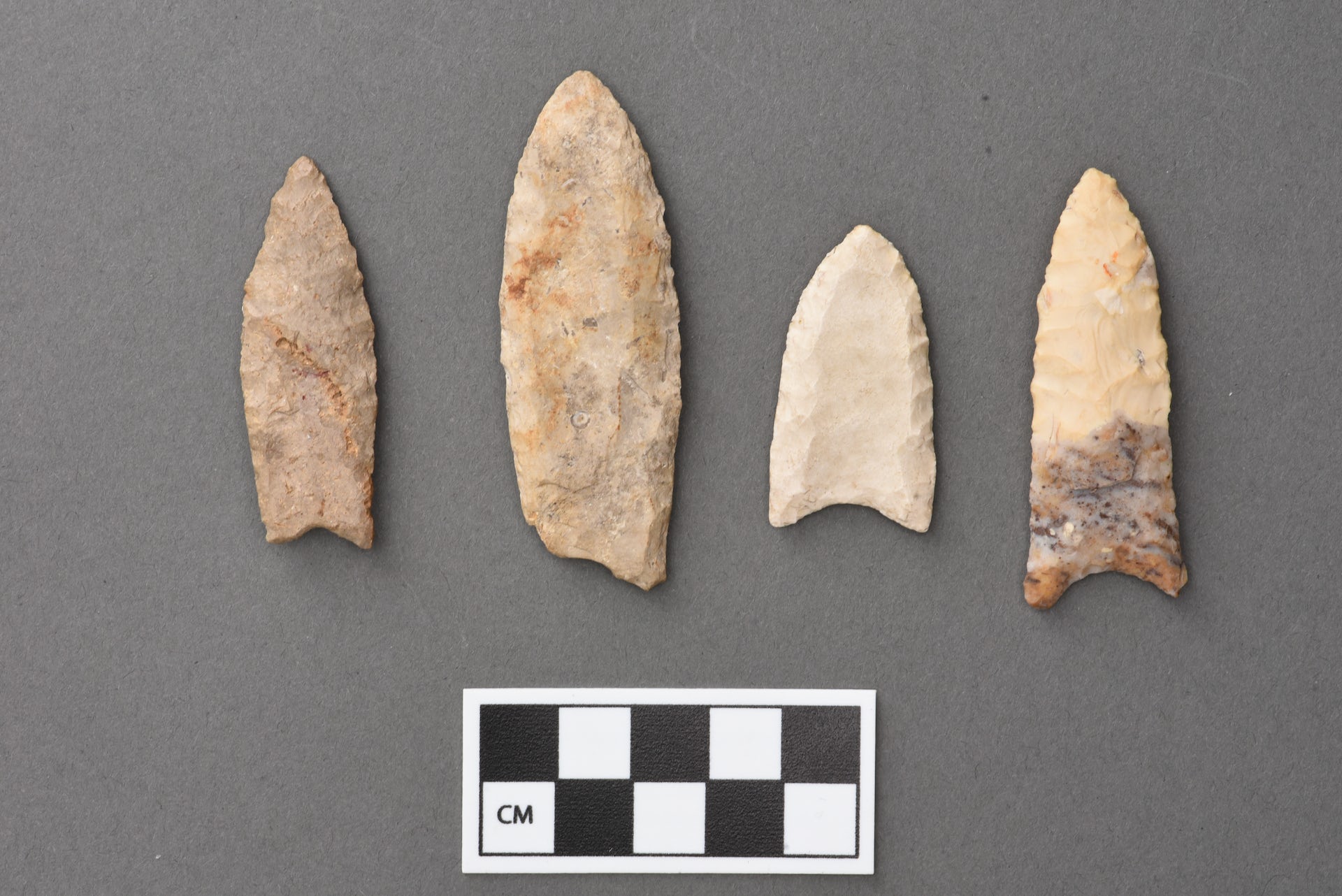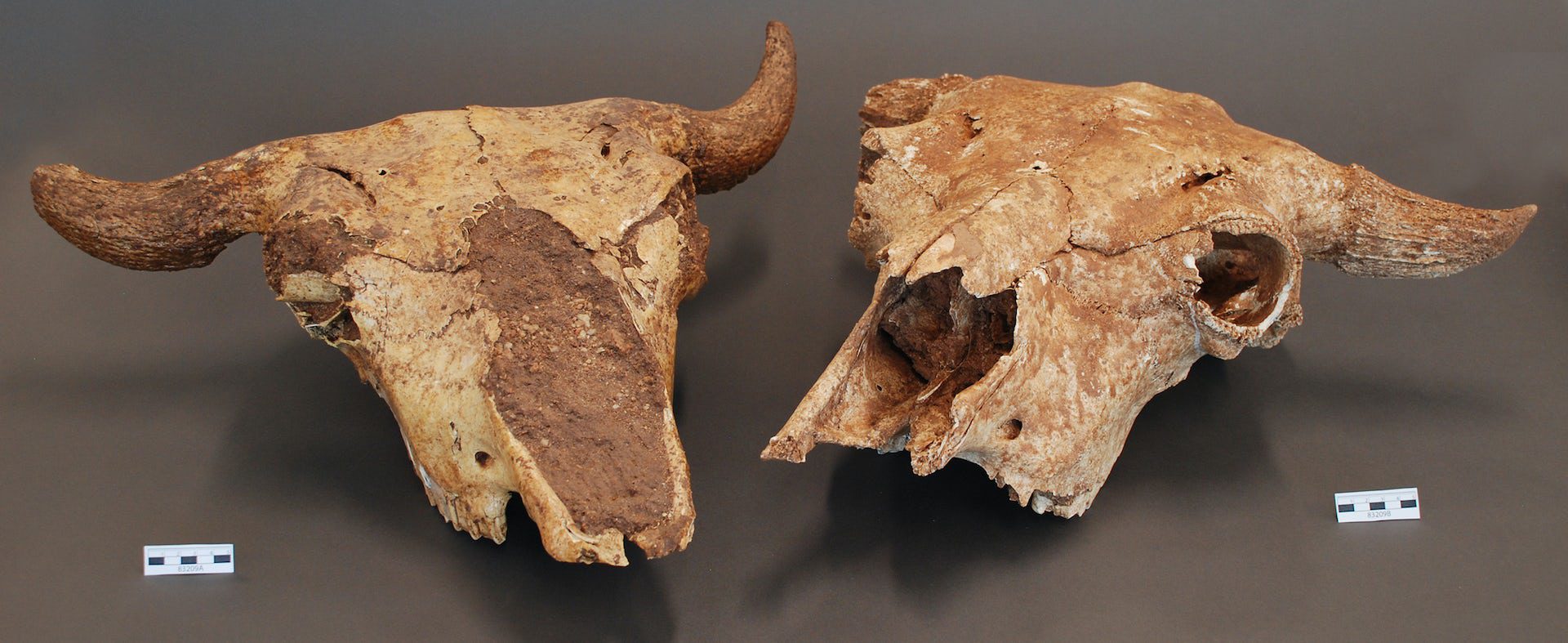![]() One of the most common stereotypes about the human past is that men did the hunting while women did the gathering. That gendered division of labor, the story goes, would have provided the meat and plant foods people needed to survive.
One of the most common stereotypes about the human past is that men did the hunting while women did the gathering. That gendered division of labor, the story goes, would have provided the meat and plant foods people needed to survive.
That characterization of our time as a species exclusively reliant on wild foods – before people started domesticating plants and animals more than 10,000 years ago – matches the pattern anthropologists observed among hunter-gatherers during the 19th and early 20th centuries. Virtually all of the large-game hunting they documented was performed by men.

Stone Folsom points, which date to between 11,000 and 10,000 years ago, are associated with the prehistoric hunting of bison. UMMAA 27673, 39802, 30442 and 37737, Courtesy of the University of Michigan Museum of Anthropological Archaeology
It’s an open question whether these ethnographic accounts of labor are truly representative of recent hunter-gatherers’ subsistence behaviors. Regardless, they definitely fueled assumptions that a gendered division of labor arose early in our species’ evolution. Current employment statistics do little to disrupt that thinking; in a recent analysis, just 13% of hunters, fishers and trappers in the U.S. were women.
Still, as an archaeologist, I’ve spent much of my career studying how people of the past got their food. I can’t always square my observations with the “man the hunter” stereotype.
A long-standing anthropological assumption
First, I want to note that this article uses “women” to describe people biologically equipped to experience pregnancy, while recognizing that not all people who identify as women are so equipped, and not all people so equipped identify as women.
I am using this definition here because reproduction is at the heart of many hypotheses about when and why subsistence labor became a gendered activity. As the thinking goes, women gathered because it was a low-risk way to provide dependent children with a reliable stream of nutrients. Men hunted either to round out the household diet or to use difficult-to-acquire meat as a way to attract potential mates.
One of the things that has come to trouble me about attempts to test related hypotheses using archaeological data – some of my own attempts included – is that they assume plants and animals are mutually exclusive food categories. Everything rests on the idea that plants and animals differ completely in how risky they are to obtain, their nutrient profiles and their abundance on a landscape.
It is true that highly mobile large-game species such as bison, caribou and guanaco (a deer-sized South American herbivore) were sometimes concentrated in places or seasons where plants edible to humans were scarce. But what if people could get the plant portion of their diets from the animals themselves?
Animal prey as a source of plant-based food
The plant material undergoing digestion in the stomachs and intestines of large ruminant herbivores is a not-so-appetizing substance called digesta. This partially digested matter is edible to humans and rich in carbohydrates, which are pretty much absent from animal tissues.
Conversely, animal tissues are rich in protein and, in some seasons, fats – nutrients unavailable in many plants or that occur in such small amounts that a person would need to eat impractically large quantities to meet daily nutritional requirements from plants alone.
If past peoples ate digesta, a big herbivore with a full belly would, in essence, be one-stop shopping for total nutrition.

Killing a bison could provide a source of both protein and carbs, if you consider the digesta. UMMAA 83209 a and b, Courtesy of the University of Michigan Museum of Anthropological Archaeology
To explore the potential and implications of digesta as a source of carbohydrates, I recently compared institutional dietary guidelines to person-days of nutrition per animal using a 1,000-pound (450-kilogram) bison as a model. First I compiled available estimates for protein in a bison’s own tissues and for carbohydrates in digesta. Using that data, I found that a group of 25 adults could meet the U.S. Department of Agriculture’s recommended daily averages for protein and carbohydrates for three full days eating only bison meat and digesta from one animal.
Among past peoples, consuming digesta would have relaxed the demand for fresh plant foods, perhaps changing the dynamics of subsistence labor.
Recalibrating the risk if everyone hunts
One of the risks typically associated with large-game hunting is that of failure. According to the evolutionary hypotheses around gendered division of labor, when risk of hunting failure is high – that is, the likelihood of bagging an animal on any given hunting trip is low – women should choose more reliable resources to provision children, even if it means long hours of gathering. The cost of failure is simply too high to do otherwise.
However, there is evidence to suggest that large game was much more abundant in North America, for example, before the 19th- and 20th-century ethnographers observed foraging behaviors. If high-yield resources like bison could have been acquired with low risk, and the animals’ digesta was also consumed, women may have been more likely to participate in hunting. Under those circumstances, hunting could have provided total nutrition, eliminating the need to obtain protein and carbohydrates from separate sources that might have been widely spread across a landscape.
And, statistically speaking, women’s participation in hunting would also have helped reduce the risk of failure. My models show that, if all 25 of the people in a hypothetical group participated in the hunt, rather than just the men, and all agreed to share when successful, each hunter would have had to be successful only about five times a year for the group to subsist entirely on bison and digesta. Of course, real life is more complicated than the model suggests, but the exercise illustrates potential benefits of both digesta and female hunting.
Ethnographically documented foragers did routinely eat digesta, especially where herbivores were plentiful but plants edible to humans were scarce, as in the Arctic, where prey’s stomach contents was an important source of carbohydrates.
I believe eating digesta may have been a more common practice in the past, but direct evidence is frustratingly hard to come by. In at least one instance, plant species present in the mineralized plaque of a Neanderthal individual’s teeth point to digesta as a source of nutrients. To systematically study past digesta consumption and its knock-on effects, including female hunting, researchers will need to draw on multiple lines of archaeological evidence and insights gained from models like the ones I developed.![]()
Raven Garvey, Associate Professor of Anthropology; Curator of High Latitude and Western North American Archaeology, Museum of Anthropological Archaeology; Faculty Affiliate, Research Center for Group Dynamics, University of Michigan
This article is republished from The Conversation under a Creative Commons license. Read the original article.
Source Link: Could An Unusual Part Of The Real Paleo Diet Have Impacted Prehistoric Hunting Gender Roles?